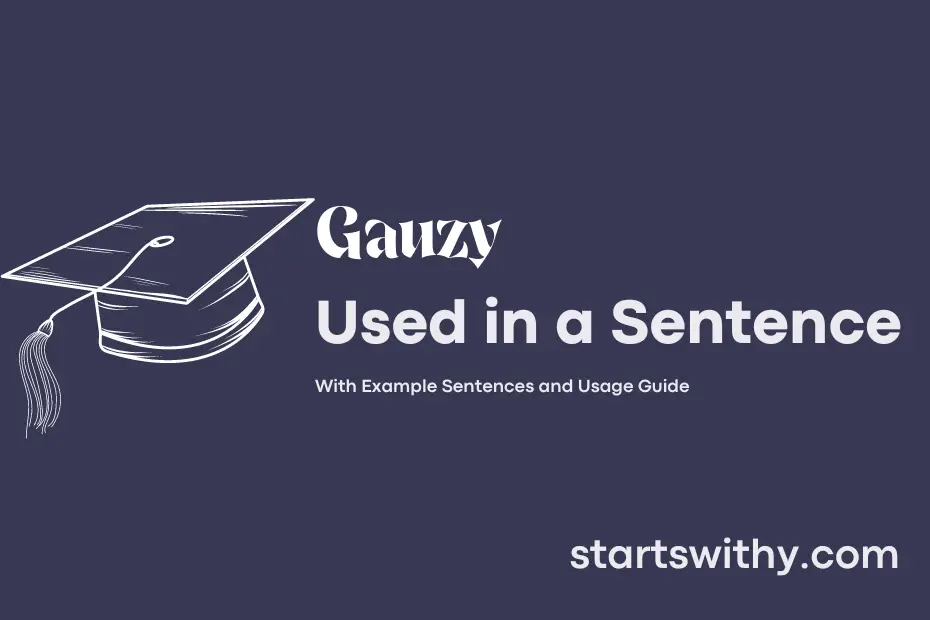Ever wondered how to craft a sentence that paints a vivid picture with just a few words? Welcome to the world of gauzy sentences, where a delicate and dreamy quality is achieved through subtly layered descriptions.
A gauzy sentence is like looking through a sheer veil – it’s ethereal, light, and often imbued with a sense of mystery or nostalgia. By using soft, vague, or translucent language, these sentences evoke a dream-like quality that allows readers to fill in the gaps with their own imagination.
7 Examples Of Gauzy Used In a Sentence For Kids
- The gauzy curtains fluttered in the breeze.
- The gauzy fabric felt soft against my skin.
- I could see through the gauzy veil.
- The princess wore a gauzy gown to the royal ball.
- The morning sun shone through the gauzy mist.
- The gauzy scarf danced in the wind.
- The fairy’s wings were delicate and gauzy.
14 Sentences with Gauzy Examples
- The gauzy curtains in the hostel room cast a soft and dreamy light in the evenings.
- The gauzy fabric of her scarf fluttered in the breeze as she walked across the campus.
- The gauzy material of the new saree she wore to the college cultural fest was both elegant and comfortable.
- The gauzy mist settled over the mountains, creating a picturesque view from the college campus.
- The gauzy veil added a touch of mystery to her dance performance during the college talent show.
- The gauzy filter on his camera lens added a soft and ethereal quality to the photos he took around campus.
- The gauzy curtains in the study lounge provided just enough privacy for students to focus on their studies.
- The gauzy shawl she wore during the college farewell party kept her warm without feeling bulky.
- The gauzy texture of the paper she used for her art project gave it a delicate and intricate look.
- The gauzy glow of the fairy lights strung across the college courtyard created a magical ambiance during the night.
- The gauzy drapes in the lecture hall fluttered gently in the air conditioning breeze.
- The gauzy evening light filtering through the trees made the college campus look even more beautiful.
- The gauzy curtains in the student lounge gave a sense of coziness and privacy to those studying there.
- The gauzy filter on her laptop screen helped reduce the glare and eye strain during long study sessions.
How To Use Gauzy in Sentences?
To use Gauzy in a sentence, start by identifying the context in which you want to use the word. Gauzy is an adjective that describes something as thin, light, and transparent, typically referring to fabric or material.
Here is an example sentence using Gauzy:
“The bride wore a gauzy veil that floated behind her as she walked down the aisle.”
When using Gauzy in a sentence, make sure that it is describing something that has the characteristics of being light, transparent, or delicate. You can use Gauzy to add a descriptive element to your writing and create a visual image for your readers.
Here are a few more examples of how you can incorporate Gauzy into your sentences:
-
“She hung gauzy curtains in her bedroom to let in the soft, filtered light.”
-
“The artist painted a gauzy landscape that seemed to shimmer in the sunlight.”
-
“The dancer’s costume was made of a gauzy fabric that flowed gracefully with her movements.”
Remember, when using Gauzy in a sentence, consider the visual and sensory effects you want to convey to your audience. Practice incorporating Gauzy into your writing to enhance the imagery and evoke a specific atmosphere.
Conclusion
In writing, sentences with “gauzy” often describe something as delicate, light, or translucent. When used in the context of describing fabric or imagery, “gauzy” paints a vivid picture of softness and airy quality. Such sentences evoke a sense of ethereal beauty and can create a dreamy or fantastical atmosphere in prose. By incorporating “gauzy” into writing, authors can add a layer of visual and tactile detail that enhances the reader’s perception of the scene or object being described.
Overall, sentences with “gauzy” contribute to crafting descriptive and evocative language that engages the reader’s senses and sparks their imagination. Through the use of this word, writers can create a rich tapestry of imagery that brings their descriptions to life, allowing readers to vividly envision the light, airy, and delicate qualities of the subject at hand.



